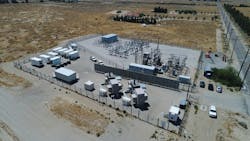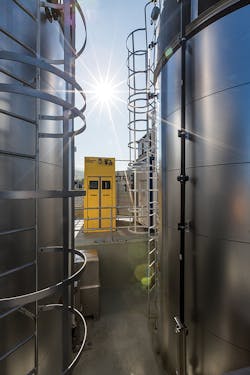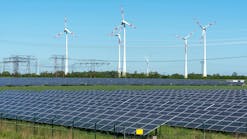Over the last two decades, the energy industry has been in a constant state of transformation, catalyzed by dramatic increases in clean energy and a multitude of technology innovations. In California, the spotlight has been on maximizing the use and storage of renewable energy to meet climate goals. As an early adopter of clean energy innovations, San Diego Gas & Electric (SDG&E) has been a key partner in California’s efforts to fight climate change and reduce greenhouse gas (GHG) emissions.
Today, SDG&E supplies around 45% renewable energy to every family and business in the San Diego-Southern Orange County, California, U.S. region, up 1% from nearly two decades ago. The national average is about 10%. SDG&E’s mission to become America’s cleanest energy infrastructure utility is complemented by its relentless efforts to enhance the safety and reliability of energy delivery.
California has been racing against the climate change clock, creating policies, incentives and programs to achieve higher levels of clean energy for powering homes, businesses, goods movement and transportation. As more solar and wind energy come on-line and plug into the power grid, investments are needed to maintain reliability, harness the value of excess electrons and keep costs low for customers. With an abundance of solar and wind energy now flooding the grid, curtailment is an unfortunate, harsh reality. This challenge has led to an emerging market and increasingly important energy resource in California: the rise of energy storage. Excited about the many potential uses for energy storage, SDG&E currently is pursuing multiple projects on this front.
The Emerging Market
In the last decade, interest in energy storage—both utility scale as well as residential and commercial—has increased dramatically as a result of climate policy goals, such as California’s Senate Bill (SB) 100, which mandates the state’s grid be 100% carbon free by 2045, and the Federal Energy Regulatory Commission’s Order 841, which directs system operators to enable utility-scale batteries so they can engage in the wholesale energy, capacity and ancillary services markets.
As demand increases, the market has responded with a variety of energy storage technologies and applications. Whether a large-scale Lithium-ion battery for grid use or a behind-the-meter (BTM) battery for a photovoltaic (PV) system, batteries are becoming commonplace for energy consumers. Electric vehicles with longer-duration batteries are coming down in price, creating more choices for consumers. New technology also is emerging to enable bidirectional flow of electricity between the grid and vehicles. In the future, imagine consumers plugging electric vehicles into their houses to help power some of their electricity needs during peak hours.
SDG&E recently won approval for a medium- and heavy-duty transportation electrification program that includes a vehicle-to-grid pilot for electric vehicles. Under this initiative, large batteries on school buses will soak up electrons from the grid when energy is plentiful—such as during the day when solar power is abundant—and discharge the energy when demand on the power grid is high.
As battery prices decline, additional utility storage use cases become economical. For example, utility-scale four-hour Lithium-ion battery storage is being considered as a viable competitor to gas-combustion turbine peaker plants. In 2017, the California Independent System (ISO) found energy storage partially could fill the role of the planned Puente natural-gas peaker plant in Oxnard, California, leading developer NRG Energy Inc. to abandon a traditional generation project.
As the market for energy storage evolves, utilities like SDG&E must balance the everyday energy needs of its customers with the prospective technology coming on-line. While some technologies may substitute or replace traditional power generation, there is no substitution for safe and reliable service at an affordable price. SDG&E has been deploying energy storage at an aggressive pace for grid reliability and to advance the integration of renewable power sources.
Storage Portfolio
Energy storage is playing a key role in SDG&E’s commitment to delivering clean, safe and reliable energy. As of mid-2019, the utility has more than 100 MW of energy storage connected to the power grid in San Diego, with more projects coming on-line in the next few years. By 2025, the utility, which serves 3.6 million people in San Diego and Southern Orange counties, plans to have approximately 200 MW of energy storage connected to grid. The current crown jewel, a 30-MW facility in SDG&E’s energy storage portfolio is proving to be a valuable energy asset for customers and the grid.
In 2017, in partnership with Fluence, SDG&E built the 30-MW, 120-MWh storage facility in Escondido, California. The facility comprises approximately 400,000 batteries installed in 20,000 modules within 24 containers. At capacity, it can provide electricity to 20,000 homes for four hours. The facility has a multitude of benefits for the region and SDG&E customers. First, it helps to balance the abundance of solar power entering the energy grid during peak daylight hours. Second, the facility enables energy time-shift, so SDG&E can maximize value and benefits for its customers about when to supply and store energy.
Time-shifting enables the utility to charge customers lower rates during traditionally high-cost peak demand. By taking in and storing electricity during the day—when it is most abundant and, therefore, at the lowest cost—SDG&E can release low-cost stored electricity in the early evening, when solar generation has dissipated and demand has picked up because people are returning home from work.
SDG&E also is testing other storage technologies in a small town called Borrego Springs, near San Diego, that is uniquely positioned to benefit from a microgrid. In fall 2013, intense thunderstorms blew into Borrego Springs, causing heavy rain, flash floods, high winds and severe lightning that shattered a power pole on the only transmission line serving the community. This took down 20 utility poles and cut electricity to the town’s 2780 power customers. SDG&E repair crews arrived quickly on the scene and worked through the night to restore power to all customers.
This was not a run-of-the-mill power restoration, because crews were able to make use of a special advantage: SDG&E’s Borrego Springs microgrid, which enabled a faster, more complete recovery. Since then, the microgrid has been activated on several occasions to keep power flowing when outages occur on the larger grid. The microgrid includes three battery systems, totaling 1.575 MW, and is connected to a nearby 26-MW solar plant, two 1.8-MW distributed generators and one 0.25-MW ultracapacitor. The microgrid provides enhanced reliability for the Borrego Springs community. SDG&E is looking to add similar microgrids in the future for added resiliency, particularly in rural communities, often prone to high winds and dangerous fire conditions.
In 2017, the utility initiated a demonstration project to test a 2-MW, 8-MWh vanadium redox flow (VRF) battery storage technology. The project is underway in partnership with the New Energy and Industrial Technology Development Organization (NEDO) of Sumitomo, Japan, and the California Governor’s Office of Business and Economic Development. This four-year demonstration project is testing whether flow battery technology economically can enhance the delivery of reliable energy to customers, integrate growing amounts of renewable energy and increase flexibility in the way the utility manages the power grid. On April 30, 2019, this VRF battery was connected to the California ISO market.
Growing Use Cases
Implemented through a diverse set of technology solutions, energy storage can provide a wide range of power grid benefits, such as renewable integration, customer bill management and peak shaving, and emergency backup power for critical public safety facilities.
Energy storage today predominantly is electrochemical (that is, batteries) and mechanical systems. Different storage technologies are used for different applications, with some key trade-offs being energy density, storage duration, round-trip conversion efficiency, ramp rates and scalability. To date, use cases requiring high energy density have relied on battery systems while mechanically based pumped-hydro storage systems dominate deployment of bulk energy storage.
Major SDG&E energy storage deployments have been based on providing the California ISO energy and ancillary services. Additional deployments have supported distribution system resiliency and microgrid applications. Other use cases at both the California ISO and utility levels, like general renewable curtailment minimization and distribution deferral, are possible today but could become more common in the future. Similarly, BTM use cases like time-of-use bill management and PV self-consumption could increase as rates evolve and the price of storage systems marketed by private companies decline.
SDG&E expects storage to become a cost-effective solution in additional grid-scale use cases as costs decline. An emerging use case for energy storage is to enable renewable-powered microgrids to remain energized despite being isolated from the grid for long periods. When properly sized, energy storage also is an ideal balancing resource in high-renewable microgrids like the one currently serving the Borrego Springs community.
SDG&E intends to expand energy storage facilities in its high-fire-threat areas. These areas are impacted by high winds, dangerous fire conditions and other threats to normal grid operations. Energy storage technology could be a useful resource to serve customers in such areas.
In the long term, meeting the SB 100 carbon-free energy mandate will require technologies that can store energy for months, not the few hours utilities are accustomed to with the current technologies dominating the market.
Deployed with the correct scale and scope, energy storage could enhance the value of the power grid dramatically. A more valuable grid has far-reaching benefits for consumers and aligns with SDG&E’s goal of becoming the cleanest, safest and most reliable energy infrastructure utility in America.
For more information:
California ISO | www.caiso.com
Fluence | https://fluenceenergy.com
NEDO | www.nedo.go.jp/english
NRG Energy | www.nrg.com
SDG&E | www.sdge.com





